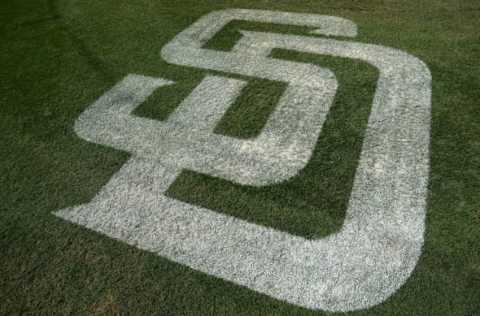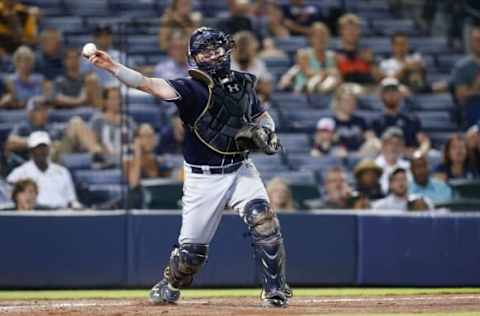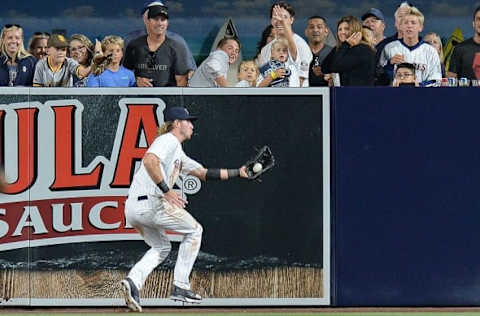San Diego Padres Top Offseason Priorities


The San Diego Padres finished the 2016 season with a record of 68-94, earning them the #3 selection in the 2017 draft. What should be the team’s priorities for the 2016-2017 offseason?
Front Office Situation
It is near impossible to see how the team can bring A.J. Preller back as the general manager of the club and expect to have the respect and trust of the rest of the league when they attempt to make deals and trades. Preller has a long-standing reputation for swinging deals in the international market when he was with the Texas Rangers that were questionable in their ethical behavior, so it’s not as if this is a first time offense by Preller by any means. Hiding medical information from teams you are attempting to trade with is about as egregious as anything a GM can do within the trading process, and the Padres are most likely going to be looking at another season of tearing down, trading off veterans that play well to get more prospects to deepen a now-deep farm system.
Now, if it’s truly something that Preller was taking the fall for something that was a directive from above him – from ownership, that is, then the team needs to reconsider its direction entirely. Actions that would isolate your team from the league in trade discussions and possibly cause your team to be excluded from future consideration in trade talks are actions that absolutely should be fire-able offenses, no matter how high up the person sits within the organization.
If the decision is to let Preller go, the Padres would be best served to make that decision by the time the World Series is over so they can enter the winter meetings in December with their new hire in place. That would give the team’s hire a chance to get himself/herself acclimated to what the club has at the major league level and the minor league level, especially with the huge influx of players brought in through the draft and international free agent signing period in 2016 that have minimal pro experience to review and would require time to talk with scouts and persons within the organization to get an idea of where these players fit within their system.
Next: Make Room

Make Room for the Kids
Fantasy baseball podcasts (and many regular baseball podcasts, frankly) were all upset in September when the promotion time came, and the Padres left their best players in AAA rather than bringing them up to the majors. What good, the argument went, would spending more time in AAA give these players when they could be playing for a major league team and get that experience?
What many pundits did not understand, but the Padres had been re-iterating since the beginning is that they were not going to rush their young players to a major league team that was struggling. On top of that, the young players in question were primarily on the AAA El Paso roster, and that team was competing for a Pacific Coast League championship, something that can be a great bonding experience for players down the road as they work their way through major league struggles together.
When those guys arrived in the big leagues, they did so with a bang. Top prospect Hunter Renfroe hit .371/.389/.800 with monster power, including back to back days against the Dodgers where he hit three home runs and drove in 11 runs. Manuel Margot may not have overwhelmed with his hitting (.649 OPS), but his defense in the outfield turned plenty of heads, as was the case with both Austin Hedges and Carlos Asuaje, who provided defensive value at catcher and second base, positions that had been sorely lacking defensive production on the season to that point.
The Padres featured a number of late-20s hitters in 2016, but many, like outfielder Travis Jankowski, outfielder Alex Dickerson, infielder Alexi Amarista, and infielder Cory Spangenberg were fringe guys at best on a typical 40-man roster, even though many produced solid seasons for the team. As they have more of their young players work their way to the major leagues, the team will need to be willing to part ways with some of these guys, and in the past, they’ve often shown a loyalty to fringe guys that perhaps should have been let go rather than holding onto a guy with more premium value.
In 2017, a big season from defensive stalwart Javier Guerra at shortstop or highly regarded hitting outfielder Michael Gettys could leap both of them from AA to the majors. The Padres also selected advanced college players in the 2016 draft in RHP Cal Quantrill, LHP Eric Lauer, and OF Buddy Reed that could move through the system very quickly, looking for an open position. Having the willingness to clear space on the roster for those players is going to be paramount to the team’s growth.
Next: Catching

Catching
If anything, coming into 2016, many thought the Padres had an abundance of catching. Derek Norris had hit .256/.333/.405 with 11 homers and 49 RBI per season for the previous three years, solid numbers as a catcher, along with playing average defense. Christian Bethancourt, acquired from Atlanta in the offseason, had the reputation as an elite defender behind the plate that had hit in the minor leagues at every level and just not yet adjusted to the major leagues. Hector Sanchez was the prototypical backup catcher, with not enough bat to start, but enough defense to keep him on the roster as a very solid backup option and late-inning defensive replacement. Last, but certainly not least, Austin Hedges had been rated as highly as a top-20 overall prospect in the game, and he was waiting in the wings in AAA as his excellent defense had just started to bloom with offensive skills to match.
Then in 2016, it all fell apart. Norris hit below the Mendoza line for the entire season, even though he did knock out 14 home runs. Bethancourt was simply not good behind the plate in anything but his arm, which led to the team trying him out in the outfield and even on the pitching mound. Sanchez actually played the best of any of the catchers, though in 46 plate appearances. And, Hedges was left in AAA for the entire season, where he mashed the ball, hitting .326/.353/.597 (PCL stats, but still!) with 21 home runs before slashing a middling .125/.154/.167 in 26 plate appearances in September.
Where do they go from here?
Norris is arbitration eligible for the second season this year, and after making $2.92 million in 2016, he’ll likely see a modest raise to the $4-5 million area next year. While that would not exactly break the bank, depending on the outcome of Wil Myers‘ first-year arbitration case, that could leave Norris as the second highest-paid player on the Padres behind Tyson Ross (who was paid $9.62 million in 2016 and can only be discounted 20 percent in arbitration even after missing nearly all of 2016, so at minimum will make ~$7.7 million). The Padres could see that as too expensive and decide to turn over the catching duties to Hedges with help from Sanchez and Bethancourt. The issue is that those 14 home runs were significant on the team that has few power sources that can be counted on in 2017, so the team may want to keep Norris for that purpose, leaving Bethancourt or Hedges as possible offseason trade chips.
Furthering all of this confusion, the Padres have a young catcher in their system, Austin Allen, who tore up the Midwest League this year offensively and earned a promotion to AA to finish the season. He’s a power-hitting catcher with a good arm that could end up moving quickly as well, and the Padres need to know where they’re headed with guys like Bethancourt and Hedges when Allen begins to knock on the door.
Next: Starting Rotation

Starting Rotation
If you were wondering why the Padres drafted two college starting pitchers who could likely move fast through their system with their first two draft picks, focused on talented starting pitchers with their trade acquisitions in the summer, and signed one of the biggest arms available on the market from Cuba, you only need to look at their rotation in 2016.
The overall numbers don’t overwhelm you with how bad the rotation was – they were sixth-worst in the NL in starter ERA, fourth worst in NL starter FIP, third worst in NL starter K/9, second worst in NL starter BB/9, and sixth worst in NL starter HR/9. Then as you dig into the numbers, you find that the Padres had 14 starters make a start for them in 2016. Only the Braves, Reds, and Dodgers had more (crazy that the Dodgers did as well as they did with the injuries they had!).
As a pretty clear definition of where the starting staff was in 2016… when a Rule V draft selection from the offseason (Luis Perdomo) leads the team in innings by over 15, you know you’ve had a rough season from your rotation. Perdoma put up a 5.71 ERA in those 146 2/3 innings, yet the Padres were in such shape that they continued to run him out. Of those starters who made 10 starts for the Padres in 2016, only Drew Pomeranz and Paul Clemens had an ERA under 4.00 on the season. I’d have won a lot of money betting on Paul Clemens to be the only one of anything to have an ERA under 4.00 before 2016.
There are reinforcements coming in the form of 2016 draft picks Cal Quantrill and Eric Lauer, who should both move quickly as college guys with high pedigree, Anderson Espinoa and Chris Paddack are both high-velocity, high-pedigree starters acquired in 2016 trades that could jump forward in a hurry, and guys like Logan Allen, Adrian Morejon, Reggie Lawson, and Mason Thompson are in the lower levels and have big-time profiles.
The issue will be 2017. Whether Tyson Ross is back or not will have a lot to do with how much the Padres believe in his health, as he’ll be an expensive option to hold onto for a low payroll team if he’s not going to throw much again in 2017. That could lead to trading Ross in the offseason to a team that can be more patient with him. Clayton Richard and Edwin Jackson each made a number of starts for the team and are free agents. The team would likely like to bring Richard back for something near his 2016 salary ($2 million), but he’s likely earned a pay raise from that in a fairly weak free agent market and could easily see three or four times that amount for a single season.
The rest of their 2016 staff will be back, which is a positive thing, but they could definitely use a veteran starter or two for their staff, and that market is fairly weak this year in a poor free agent market. The Padres could bargain shop, but frequently, you get what you pay for in pitching.
Next: Defense

Improve the Defense
The Padres were the worst defensive team in the National League, per ratings used by Fangraphs. While there was some change in the latter part of the season as some of the veteran players were traded off or released, like Matt Kemp, Melvin Upton, and Alexei Ramirez. Guys like Travis Jankowski and Manuel Margot were elite defenders in their time in the big leagues.
The biggest position of concern is shortstop. Ramirez was absolutely dreadful in the field last season, and when he left, no one really showed anything positive. Actually, that’s quite literal. Per Fangraphs’ UZR rating, not one player who played shortstop for the Padres this season produced a positive number in UZR. Utilityman Adam Rosales posted the best rating, but in a scant 71 innings. Luis Sardinas was acquired late in the season and played just over 260 innings, but he was also negative in value. He has the tools to handle the position at at least a league-replacement level until super defender Javier Guerra is ready, but his offense will need to come along to be able to keep him in the lineup each day.
More from Call to the Pen
- Philadelphia Phillies, ready for a stretch run, bomb St. Louis Cardinals
- Philadelphia Phillies: The 4 players on the franchise’s Mount Rushmore
- Boston Red Sox fans should be upset over Mookie Betts’ comment
- Analyzing the Boston Red Sox trade for Dave Henderson and Spike Owen
- 2023 MLB postseason likely to have a strange look without Yankees, Red Sox, Cardinals
The outfield should be much improved this season as the team gives Hunter Renfroe and Manuel Margot two outfield spots with the left field spot up for grabs among guys like Alex Dickerson, Jankowski, and Cristian Bethancourt. Those guys all play much better defense than the team was seeing from Upton and Kemp, so the outfield should see some improvement as it sits.
Third base and second base will be an interesting place to watch. Yangervis Solarte is not a natural third baseman, but he was one of the better hitters for the Padres in the times he was healthy, so it’s hard to get him out of the lineup. He did rank well as a second baseman in limited time last year, while Ryan Schimpf fared well when he replaced Solarte after injury. Perhaps swapping those two in their primary 2016 positions for 2017 would be advantageous, but of course there is Carlos Asuaje, acquired from the Red Sox, who is considered a very solid defender at second base, so he could also factor into this, possibly moving Schimpf into a bench/utility role.
Next: Reds Offseason Priorities
The last thing to note was that there were many guys coming off of the bench as fill-in players who were absolute zeros defensively – guys like Brett Wallace, Jabari Blash, Oswaldo Arcia, and even Alexi Amarista has been a poor defender around the infield, even though he has the ability to play multiple infield positions. The team will need to consider this to help their pitchers as the Padres pitching staff had the highest ground ball rate in the entire league this year, yet they were hitting those ground balls to a very poor defense. That’s a scary thing!